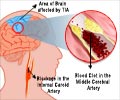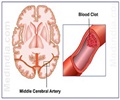Chances of continuing stroke prevention medications by stroke patients after one year, increases by 70 percent if they have a prescription in hand when discharged.

"The good news is that Ontarians are receiving very good stroke care overall," said Dr. Gustavo Saposnik, lead author of the study and director of the Stroke Research Unit of St. Michael's Hospital. "But there are still things we can do to help patients receive better quality, long-term care after a stroke. And the first thing on that list is giving each patient a prescription before he or she leaves as part of discharge planning."
According to the Heart and Stroke Foundation, there are an estimated 50,000 strokes in Canada each year. After having a stroke or minor stroke, the risk of having another stroke is greater. The risk of recurrence, however, can be reduced by more than 80 per cent by following stroke prevention strategies such as rehabilitation and taking medications.
Dr. Saposnik said that at the time of discharge most patients are more focused on the tangible issues of their recovery, such as: "What will happen at rehab?" or "What will happen when I go home?"
"Patients have other things on their minds after a stroke and it's up to us to give them the tools they need to thrive," said Dr. Saposnik, who is also an adjunct scientist at ICES.
The two types of drugs most commonly prescribed after a stroke are antihypertensives (to lower blood pressure) and statins (to lower blood cholesterol). Patients may be prescribed one of these drugs or both. Patients may remain on these drugs for the rest of their lives to prevent another stroke. About 315,000 Canadians are living with the effects of stroke.
Advertisement
There are several reasons why a patient might be discharged before receiving a prescription. Doctors may assume their patient will receive a prescription from a family doctor, whom patients are supposed to see within seven days of discharge. Another reason some patients leave without a prescription is that the prescription might be dictated in the chart but not actually delivered to patients.
Advertisement















